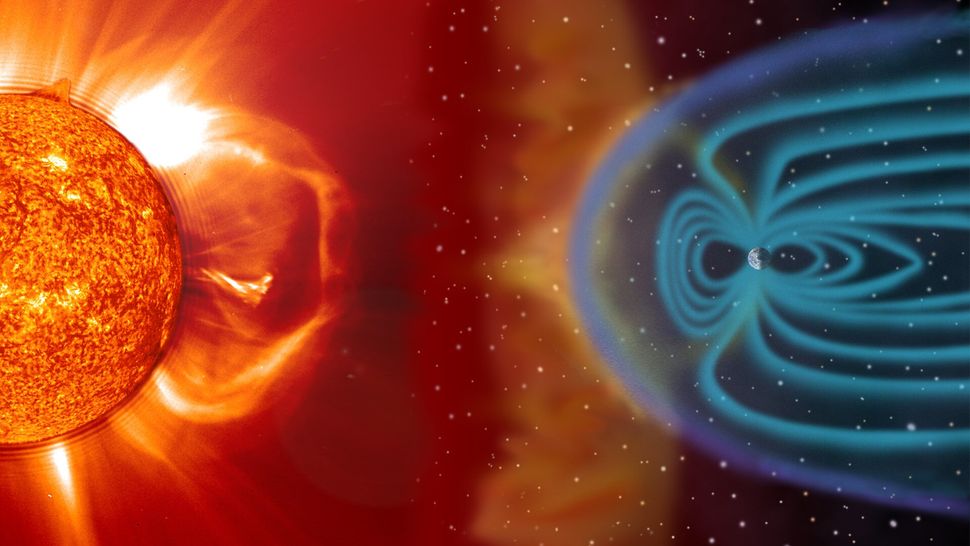The weakening of the Earth’s magnetic field has led to a dramatic acceleration in the evolution of multicellular life. Fossil evidence has been found in Brazil and South Africa that the strength of the Earth’s magnetic field was about 30 times weaker than today’s values at the end of the Ediacaran period, about 590 to 560 million years ago. One of the defining features of the Earth is its magnetic field. It forms a protective shield against high-energy particles ejected by the Sun, and thus may have provided a safer place for life to grow into the complex array of organisms we see today.
Most modern animal groups and types emerged approximately 540-520 million years ago during the so-called “Cambrian explosion” – a sharp acceleration of evolution and an increase in the diversity of multicellular creatures. At this time, the ancestors of worms, insects, fish and other vertebrates arose. Scientists have long been interested in how exactly and for what reason the evolution of multicellular creatures sharply accelerated during this period of time.
Scientists have found fossil evidence in Brazil and South Africa that the Earth’s magnetic field was about 30 times weaker than it is today at the end of the Ediacaran period, about 590 to 560 million years ago. This weakening led to a sharp acceleration in the evolution of multicellular life in the “Cambrian explosion,” the researchers write in the journal Communications Earth & Environment.
“The traditional view is that the ‘Cambrian explosion’ occurred as a result of the sharp increase in oxygen concentration in the air and water at the end of the Ediacaran period. Our measurements suggest that the increase in oxygen concentration in the atmosphere and hydrosphere was associated with a long period of sharp weakening of the planet’s magnetic field, which lasted for about 30 million years,” the study says.
This conclusion was reached by a group of American, Chinese and South African geologists led by Professor John Tarduno of the University of Rochester while studying rock samples formed in different periods of the Proterozoic era in different regions of the planet. Tarduno and his colleagues have been studying for many years how the strength of the Earth’s magnetic field has changed since its formation, for which scientists collect samples of ancient rocks and measure their residual magnetization.

Recently, geologists say, their colleagues have found possible evidence that the Earth’s magnetic field weakened significantly at the end of the Ediacaran era, shortly before the “Cambrian explosion.” Professor Tarduno and other researchers tested whether this was true by measuring the magnetization levels of igneous rock crystals that formed about 2 billion years ago in the north of modern-day South Africa and 590 million years ago in the south of modern-day Brazil.
These measurements showed that 2 billion years ago the Earth already had a fairly strong magnetic field, comparable in strength to its current intensity. In turn, at the end of the Ediacaran era, the Earth had an abnormally weak magnetic field, whose intensity did not exceed 1.5 microtesla. This value is approximately three dozen times lower than the current strength of the Earth’s magnetic field (about 40 microtesla).
Calculations conducted by scientists show that this weakening accelerated the “escape” of hydrogen ions from the upper layers of the atmosphere into outer space several times under the influence of solar flares and solar wind strikes. As a result, the proportion of oxygen in the atmosphere increased by several percent, which created favorable conditions for the emergence and rapid evolution of multicellular life.
The most stunning signs of the Earth’s magnetic field are the auroras, dancing curtains of multicolored light that appear near the North and South Poles during periods of high solar activity. Another sign that the Earth has a magnetic field is that a compass points north no matter where you are on the planet.
But how can we know if other planets or bodies in our solar system have magnetic fields? And is it possible to know if distant exoplanets have magnetic fields?
We know that the solar system’s gas giants (Jupiter and Saturn) and ice giants (Uranus and Neptune) have strong magnetic fields of their own. But things are a little more complicated with the terrestrial planets and moons, says Joseph G. O’Rourke, a planetary scientist at Arizona State University.
Earth, Mercury, and Jupiter’s moon Ganymede all have internally generated magnetic fields today. Mars and Earth’s moon have old crustal rocks that retain remnants of magnetization from magnetic fields that existed early in their history, O’Rourke said.
As for Earth’s other neighbor, “Venus hasn’t been found to have any intrinsic magnetism, but we haven’t gotten instruments close enough to the surface to look for magnetized crust,” he added.
For a magnetic field to exist on a planet or moon, there must be a large volume of conducting fluid moving inside the body. The body would lose its magnetic field if those materials stopped moving, or if the temperature difference between the heating and cooling of the materials was not sufficient to cause convection of the fluids inside the planet or moon, in which case the fluids would move too slowly, O’Rourke said.
According to O’Rourke, in the case of the apparent absence of a magnetosphere on, for example, Venus, there are four possibilities.
The conventional idea is that Venus has a core like Earth’s, but it cools too slowly. Because Venus lacks plate tectonics, its interior may cool more slowly than Earth’s.

A coronal mass ejection erupting from the Sun and then striking the Earth’s magnetosphere. ESA/NASA – SOHO/LASCO/EIT
However, an alternative possibility is that the interior of Venus is entirely solid. For this to be true, the planet’s core would have to be much cooler than Earth’s, which O’Rourke believes is unlikely. NASA’s Venus Radiation, Radio Science, InSAR, Topography and Spectroscopy mission, scheduled for 2031, and the European Space Agency’s EnVision mission will try to find out whether Venus’s core is at least partially liquid.
Alternatively, Venus may lack an inner core. Earth’s inner core helps generate our planet’s magnetic field. As the core crystallizes, it expels impurities (elements lighter than iron), which creates chemical buoyancy that propels the fluid. Venus may not have formed an inner core yet, so it lacks an additional energy source.
A fourth possibility, O’Rourke said, is that Venus’s core may be chemically stratified. The impact that formed the moon could have stirred up the ancient Earth’s core, allowing it to generate a magnetic field as it began to cool. However, Venus has no moons, meaning its core never mixed.
The best way to determine whether solar system bodies have magnetic fields is to send a spacecraft to the object and measure the intensity of the magnetic field with a magnetometer. However, scientists were able to remotely detect Jupiter’s magnetic field back in the 1950s by detecting radio emissions from the planet’s auroras.
O’Rourke said magnetic fields are one of the best ways to learn about the interiors of planets. The presence of a strong magnetic field tells scientists that the planet has a large reservoir of conductive fluid that can move.
A dynamo is the process by which the energy of a fluid’s motion is converted into a magnetic field, O’Rouke explained. On terrestrial planets, metallic cores can contain “dynamos,” as Earth does today. But liquid silicates (basically molten rock) also conduct electricity at extreme pressures and temperatures. Hydrogen becomes metallic deep inside gas giants like Jupiter and Saturn, giving them strong magnetic fields.
When it comes to exoplanets — planets outside the solar system — planetary scientists have not yet definitively detected magnetic fields. But astronomers have detected auroras caused by magnetic fields around small stars known as brown dwarfs and low-mass M dwarfs.
Planetary scientists currently debate whether magnetic fields generally protect planetary atmospheres. On the one hand, magnetic fields may protect the atmosphere from stellar winds, especially near the magnetic equator. On the other hand, magnetic fields can direct charged particles toward the polar regions, and a number of mechanisms that facilitate atmospheric escape are not strongly affected by magnetic fields, O’Rourke explained.
Earth has retained both a magnetic field and a habitable surface for billions of years. Mars lost most of its water to space around the time its magnetic field disappeared. Venus, a hellish world, has no magnetic field. In our solar system, magnetism correlates with habitability. However, correlation is not causation.
As we get a larger sample size of exoplanets through observations with the James Webb Space Telescope, planetary scientists will begin to uncover the relationship between magnetic fields and planetary habitability. Auroras may be one of the first indicators that we should be looking for signs of life.
The Earth’s magnetic field has a tail. When the solar wind hits the planet, it leaves behind a kind of long shadow that trails behind our planet. Scientists call this magnetic tail a magnetotail. The magnetotail is usually littered with magnetic storms.
For the past few years, scientists have known about the magnetotail mystery: the missing storm. They have found signs of a storm, but no detectable storm to match it. NASA’s Magnetospheric Multiscale (MMS) mission is currently investigating the matter.

NASA/Goddard Space Flight Center – Conceptual Imagery Laboratory
MMS is made up of four satellites that were launched on the same Atlas V rocket in 2015. Since then, the quartet has been studying Earth’s magnetopause: the boundary of the region dominated by the planet’s magnetic field. The magnetopause is constantly rife with magnetic reconnections, which refer to when the lines that make up the magnetic field come together, break apart, and then reconnect, creating brilliant streams of heat and kinetic energy. These reconnections, if they occur in Earth’s atmosphere, can cause auroras.
Scientists call these gusts substorms. In 2017, MMS detected the characteristic magnetic reconnection of a substorm, but there was no real substorm that could have coincided with it. The substorm should have been accompanied by strong electric currents and magnetic field fluctuations, but MMS found no evidence of either.
“We didn’t study the motion of magnetic field lines on a global scale, so it’s possible that this unusual substorm was a very localized event that MMS was able to observe,” said Andy Marshall, a postdoc at the Southwest Research Institute, in a statement. “If not, it could change our understanding of the relationship between tail-side reconnection and substorms.”
In 2025, MMS will measure magnetic reconnections in Earth’s actual magnetic field, while scientists on Earth will run simulations of the magnetic field to understand how it behaves. By comparing the two phenomena, scientists hope to solve the mystery by better understanding the precise relationship between reconnection and the events it causes.
“It is possible that there are significant differences between global magnetotail convection patterns for substorms and non-substorm magnetotail reconnection,” Marshall said.




